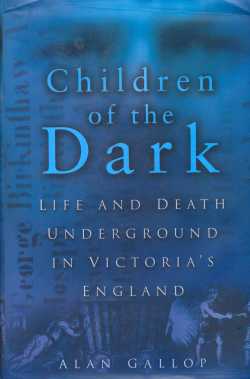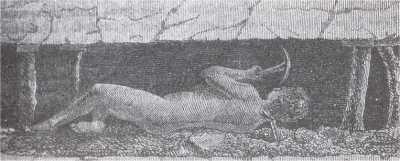
|
CHILDREN OF THE
DARK
|
|
LIFE AND DEATH UNDERGROUND IN VICTORIA'S ENGLAND. ALAN GALLOP
Alan Gallop has a great eye for detail and a great perceptiveness
in drawing for us, from the sketches and outlines left by records
and statements a touching history of child labour. The book had
me in floods of tears, as the reality that this is no tale, this
is as true as day, these were real little folk, still kids as we
would know them today, but charged with a life reserved for few
adults these days, this touches your senses. For days I couldn't
get the voices of those children out of my head, their work their
fears, their games even in that foreboding place. It comes with
many fascinating illustrations and photos. |
|
This book tells a number of stories, obviously the story of child labour, but also it is a detailed story of Barnsley pit life and in particular Silkstone. It actually builds the story around the Husker Pit disaster, when 26 children died in a flooded mine shaft. The story of which shocked a nation, although actually unlike the vast majority of mine accidents of the period, Husker was a freak accident as such, of course the fact that it was kids who died was the fault of the prevailing social and economic system which employed children wholesale in all industry. When the prohibition on child and women labour underground was forced through parliament in 1842 it was not though chiefly through concern for the broken backs, and the death and injury, the animal like labour of the young'uns. Rather the outrage of the Victorian middle class drawing room was reserved for the obscene imagery of naked men working alongside semi-naked and scantly clad young females, and children and in the dark. It was this moral hypocrisy more than concern for the kids which rapidly got them and the fully mature mining women out of the mines. The resulting hardship and poverty was given little if any thought and no relief. |
 |
|
I wholeheartedly recommend this book to pit communities, and it should be on every secondary school library shelf in all the former pit communities. Next time the topic is Victorian England and 'the Great British Empire' it might be interesting for modern kids to understand just how it was fuelled and by whom. Today in Britain child labour has gone. World wide 250 Million children (young persons under 15) work . Up to 120 million children 5- 14 have full time jobs, and a further 130 million in part time employment. At least a quarter of the worlds poorest children, 600 million live in absolute poverty. Many of the kids world wide work in mining and quarrying and other dangerous employment. The answer now as then cannot be a simple knee jerk reaction, but a systematic root and branch redistribution of wealth and power from rich and powerful to poor and powerless. Decent wages, safety standards, shorter hours, paid education, pension rights for their parents and grandparents etc. as a prelude to raising the working ages and prohibition from all dangerous employment in the sensible road to tread. Closing down the sweat shops which employ the kids might make folk in the west feel a comfortable glow of liberal satisfaction, but to the kid starving outside the closed factory and watching his family starve too as the loss of the incremental supplement salary tiny though that was, tips the whole lot into starvation and death. The souls of the kids in the dark of the Yorkshire mines would seek a more sensible and considered solution. Alan Gallop. Children Of The Dark. Life and Death underground in
Victoria's England. ISBN 07509 30942
|
